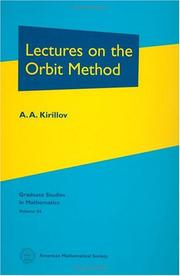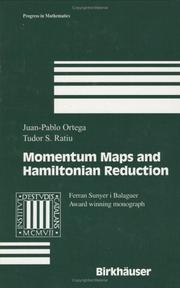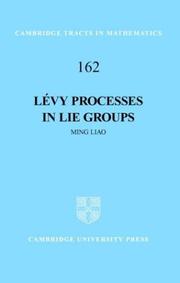| Listing 1 - 10 of 10 |
Sort by
|

ISBN: 0821835300 Year: 2004 Publisher: Providence, R.I. : American Mathematical Society,
Abstract | Keywords | Export | Availability | Bookmark
 Loading...
Loading...Choose an application
- Reference Manager
- EndNote
- RefWorks (Direct export to RefWorks)
Book
ISBN: 1470417995 Year: 2004 Publisher: Providence, Rhode Island : American Mathematical Society,
Abstract | Keywords | Export | Availability | Bookmark
 Loading...
Loading...Choose an application
- Reference Manager
- EndNote
- RefWorks (Direct export to RefWorks)

ISBN: 3037190027 Year: 2004 Publisher: Zurich European Mathematical Society
Abstract | Keywords | Export | Availability | Bookmark
 Loading...
Loading...Choose an application
- Reference Manager
- EndNote
- RefWorks (Direct export to RefWorks)

ISBN: 0817643079 Year: 2004 Publisher: Boston (Mass.) : Birkhäuser,
Abstract | Keywords | Export | Availability | Bookmark
 Loading...
Loading...Choose an application
- Reference Manager
- EndNote
- RefWorks (Direct export to RefWorks)
Global analysis (Mathematics). --- Global differential geometry. --- Hamiltonian systems. --- Lie groups.

ISBN: 1860944825 Year: 2004 Publisher: London Imperial college press
Abstract | Keywords | Export | Availability | Bookmark
 Loading...
Loading...Choose an application
- Reference Manager
- EndNote
- RefWorks (Direct export to RefWorks)
Compact groups --- Finite groups --- Group theory --- Lie groups --- Topological groups

ISBN: 0387211543 1441919376 1475740948 Year: 2004 Publisher: Berlin Springer
Abstract | Keywords | Export | Availability | Bookmark
 Loading...
Loading...Choose an application
- Reference Manager
- EndNote
- RefWorks (Direct export to RefWorks)
This book is intended for a one year graduate course on Lie groups and Lie algebras. The author proceeds beyond the representation theory of compact Lie groups (which is the basis of many texts) and provides a carefully chosen range of material to give the student the bigger picture. For compact Lie groups, the Peter-Weyl theorem, conjugacy of maximal tori (two proofs), Weyl character formula and more are covered. The book continues with the study of complex analytic groups, then general noncompact Lie groups, including the Coxeter presentation of the Weyl group, the Iwasawa and Bruhat decompositions, Cartan decomposition, symmetric spaces, Cayley transforms, relative root systems, Satake diagrams, extended Dynkin diagrams and a survey of the ways Lie groups may be embedded in one another. The book culminates in a ``topics'' section giving depth to the student's understanding of representation theory, taking the Frobenius-Schur duality between the representation theory of the symmetric group and the unitary groups as a unifying theme, with many applications in diverse areas such as random matrix theory, minors of Toeplitz matrices, symmetric algebra decompositions, Gelfand pairs, Hecke algebras, representations of finite general linear groups and the cohomology of Grassmannians and flag varieties. Daniel Bump is Professor of Mathematics at Stanford University. His research is in automorphic forms, representation theory and number theory. He is a co-author of GNU Go, a computer program that plays the game of Go. His previous books include Automorphic Forms and Representations (Cambridge University Press 1997) and Algebraic Geometry (World Scientific 1998).
Lie groups. --- Lie groups --- Groups, Lie --- Lie algebras --- Symmetric spaces --- Topological groups --- Topological groups. --- Group theory. --- Topological Groups, Lie Groups. --- Group Theory and Generalizations. --- Groups, Theory of --- Substitutions (Mathematics) --- Algebra --- Groups, Topological --- Continuous groups

ISBN: 1280190116 9786610190119 1402025459 1402025440 Year: 2004 Publisher: Dordrecht ; London : Kluwer Academic Publishers,
Abstract | Keywords | Export | Availability | Bookmark
 Loading...
Loading...Choose an application
- Reference Manager
- EndNote
- RefWorks (Direct export to RefWorks)
As K. Nomizu has justly noted [K. Nomizu, 56], Differential Geometry ever will be initiating newer and newer aspects of the theory of Lie groups. This monograph is devoted to just some such aspects of Lie groups and Lie algebras. New differential geometric problems came into being in connection with so called subsymmetric spaces, subsymmetries, and mirrors introduced in our works dating back to 1957 [L.V. Sabinin, 58a,59a,59b]. In addition, the exploration of mirrors and systems of mirrors is of interest in the case of symmetric spaces. Geometrically, the most rich in content there appeared to be the homogeneous Riemannian spaces with systems of mirrors generated by commuting subsymmetries, in particular, so called tri-symmetric spaces introduced in [L.V. Sabinin, 61b]. As to the concrete geometric problem which needs be solved and which is solved in this monograph, we indicate, for example, the problem of the classification of all tri-symmetric spaces with simple compact groups of motions. Passing from groups and subgroups connected with mirrors and subsymmetries to the corresponding Lie algebras and subalgebras leads to an important new concept of the involutive sum of Lie algebras [L.V. Sabinin, 65]. This concept is directly concerned with unitary symmetry of elementary par- cles (see [L.V. Sabinin, 95,85] and Appendix 1). The first examples of involutive (even iso-involutive) sums appeared in the - ploration of homogeneous Riemannian spaces with and axial symmetry. The consideration of spaces with mirrors [L.V. Sabinin, 59b] again led to iso-involutive sums.
Lie algebras. --- Lie groups. --- Homogeneous spaces. --- Spaces, Homogeneous --- Groups, Lie --- Algebras, Lie --- Lie groups --- Lie algebras --- Symmetric spaces --- Topological groups --- Algebra, Abstract --- Algebras, Linear

ISBN: 9780511546624 9780521836531 0511196083 9780511196089 0511195427 9780511195426 0511546629 0511194048 9780511194047 0521836530 1107150086 1280478004 9786610478002 051131440X 0511194781 9781107150089 9781280478000 6610478007 9780511194788 Year: 2004 Volume: 162 Publisher: Cambridge New York Cambridge University Press
Abstract | Keywords | Export | Availability | Bookmark
 Loading...
Loading...Choose an application
- Reference Manager
- EndNote
- RefWorks (Direct export to RefWorks)
The theory of Lévy processes in Lie groups is not merely an extension of the theory of Lévy processes in Euclidean spaces. Because of the unique structures possessed by non-commutative Lie groups, these processes exhibit certain interesting limiting properties which are not present for their counterparts in Euclidean spaces. These properties reveal a deep connection between the behaviour of the stochastic processes and the underlying algebraic and geometric structures of the Lie groups themselves. The purpose of this work is to provide an introduction to Lévy processes in general Lie groups, the limiting properties of Lévy processes in semi-simple Lie groups of non-compact type and the dynamical behavior of such processes as stochastic flows on certain homogeneous spaces. The reader is assumed to be familiar with Lie groups and stochastic analysis, but no prior knowledge of semi-simple Lie groups is required.
Lévy processes. --- Lie groups. --- Groups, Lie --- Lie algebras --- Symmetric spaces --- Topological groups --- Random walks (Mathematics) --- Lévy processes --- Lie groups --- Levy processes.

ISBN: 9780821835302 Year: 2004 Publisher: Providence, R.I. : American Mathematical Society,
Abstract | Keywords | Export | Availability | Bookmark
 Loading...
Loading...Choose an application
- Reference Manager
- EndNote
- RefWorks (Direct export to RefWorks)
Groupes de Lie nilpotents --- Nilpotent Lie groups. --- Groupes de lie --- Representation des groupes de lie
Book
ISBN: 1282194240 9786612194245 3110197944 9783110197945 9781282194243 Year: 2004 Publisher: New York Walter de Gruyter
Abstract | Keywords | Export | Availability | Bookmark
 Loading...
Loading...Choose an application
- Reference Manager
- EndNote
- RefWorks (Direct export to RefWorks)
The problem of classifying the finite-dimensional simple Lie algebras over fields of characteristic p › 0 is a long-standing one. Work on this question during the last 45 years has been directed by the Kostrikin-Shafarevich Conjecture of 1966, which states that over an algebraically closed field of characteristic p › 5 a finite-dimensional restricted simple Lie algebra is classical or of Cartan type. This conjecture was proved for p › 7 by Block and Wilson in 1988. The generalization of the Kostrikin-Shafarevich Conjecture for the general case of not necessarily restricted Lie algebras and p › 7 was announced in 1991 by Strade and Wilson and eventually proved by Strade in 1998. The final Block-Wilson-Strade-Premet Classification Theorem is a landmark result of modern mathematics and can be formulated as follows: Every finite-dimensional simple Lie algebra over an algebraically closed field of characteristic p › 3 is of classical, Cartan, or Melikian type. In the three-volume book, the author is assembling the proof of the Classification Theorem with explanations and references. The goal is a state-of-the-art account on the structure and classification theory of Lie algebras over fields of positive characteristic leading to the forefront of current research in this field. This first volume is devoted to preparing the ground for the classification work to be performed in the second and third volume. The concise presentation of the general theory underlying the subject matter and the presentation of classification results on a subclass of the simple Lie algebras for all odd primes make this volume an invaluable source and reference for all research mathematicians and advanced graduate students in albegra.
Lie algebras. --- Algebras, Lie --- Algebra, Abstract --- Algebras, Linear --- Lie groups --- Lie Algebra, Fields of Positive Characteristic, Structure Theory.
| Listing 1 - 10 of 10 |
Sort by
|

 Search
Search Feedback
Feedback About UniCat
About UniCat  Help
Help News
News